1917
PATEK PHILIPPE & Co. Masonic Wristwatch
This is a MARRIAGE watch. A
marriage watch is the term used for a new, modern case that has been used to
house a vintage pocket watch movement. Please read the sizes of this watch in
the description.
MOVEMENT: The authentic
signed by Patek Philippe movement is 100% ORIGINAL
from 1917 and has been in addition updated and engraved
by the craftsman later. The movement is running
superbly and keeping good time, recently serviced.
CASE: New gold plated 24K
case that provides with glass cover of back lid (non Patek Philippe) was made in
2015.
WATCH CRYSTAL:
The
gently domed MINERAL GLASSES are in excellent condition.
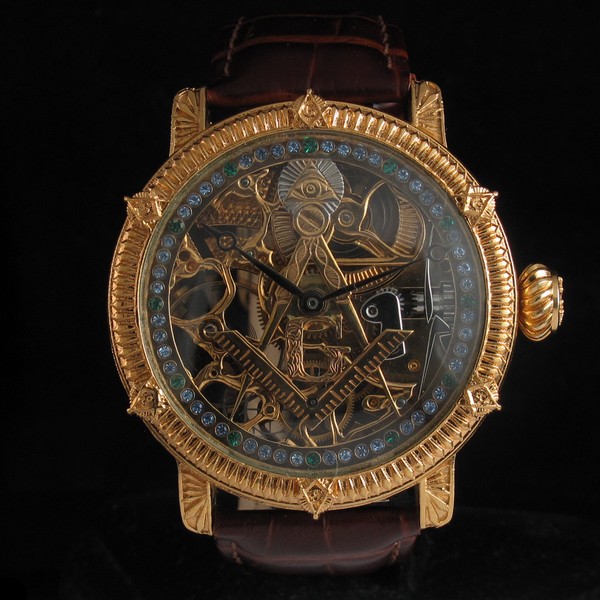
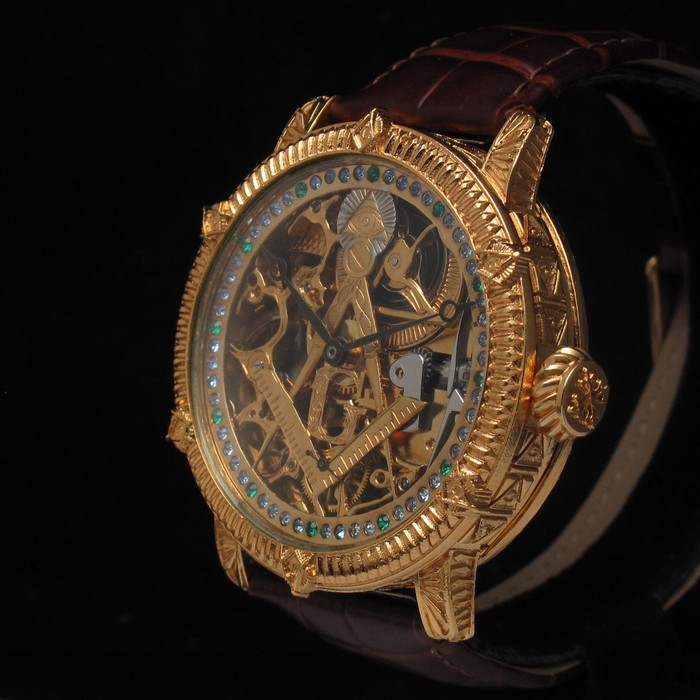
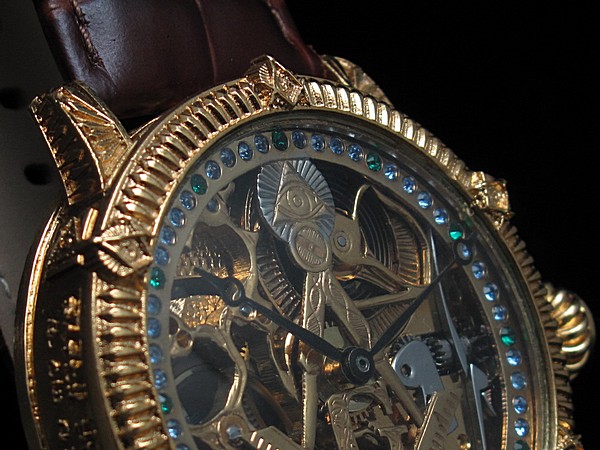
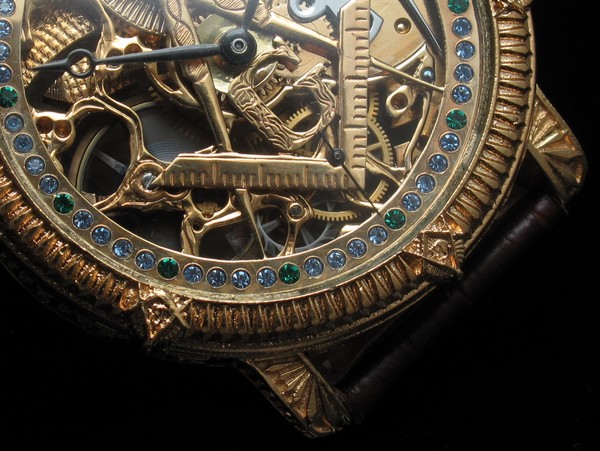
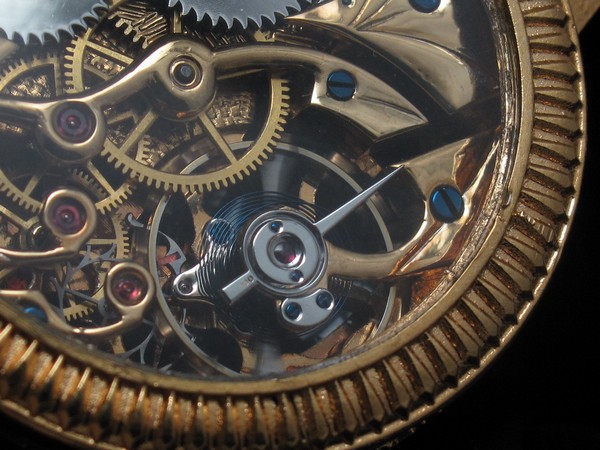
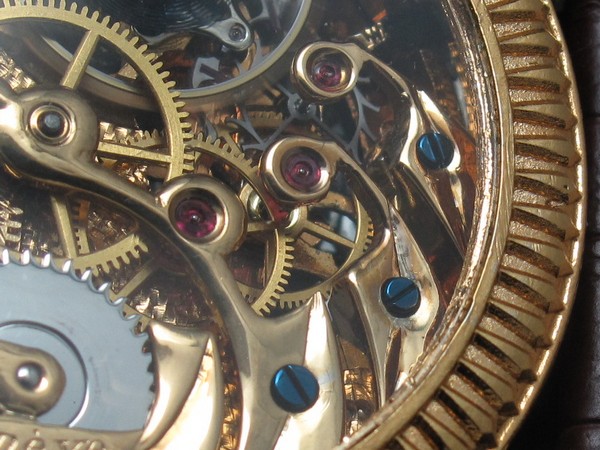
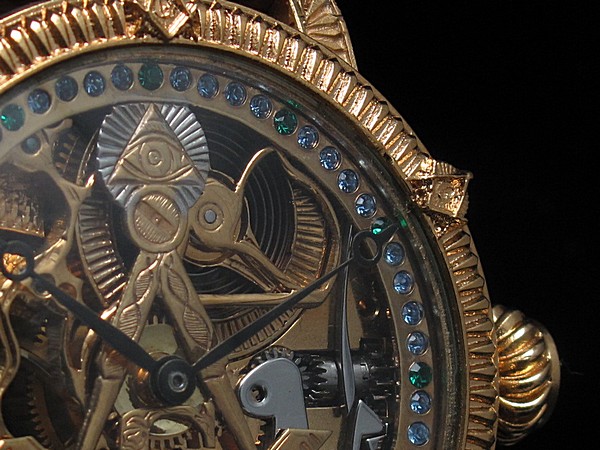
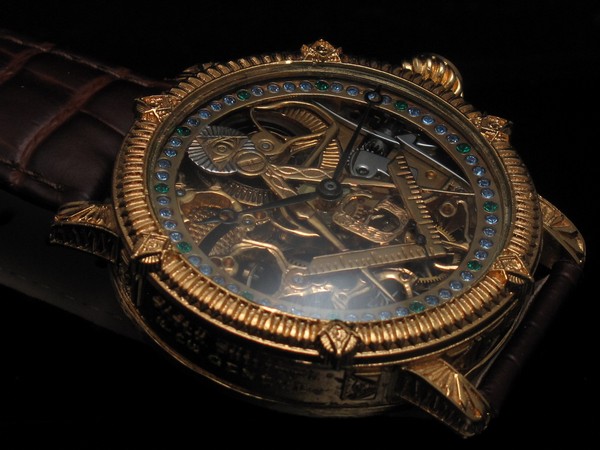
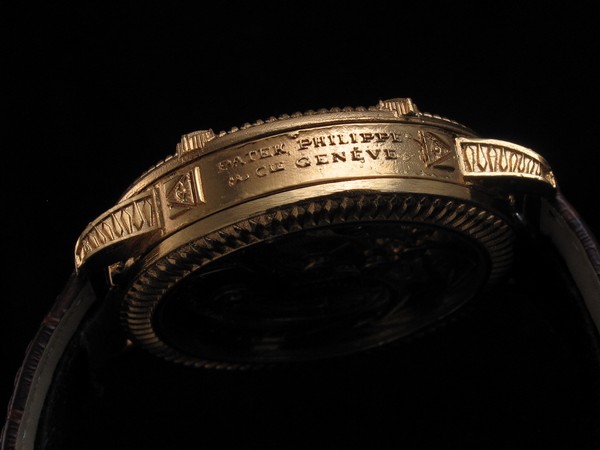

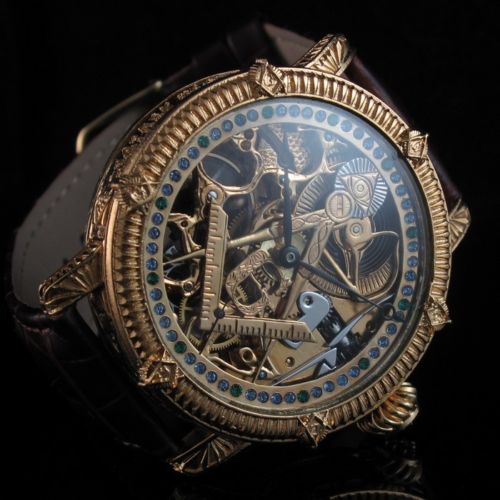
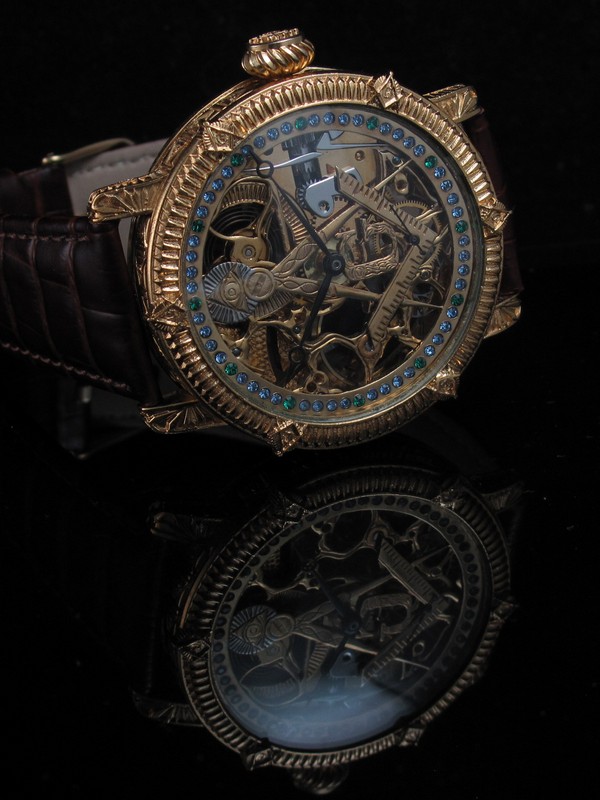
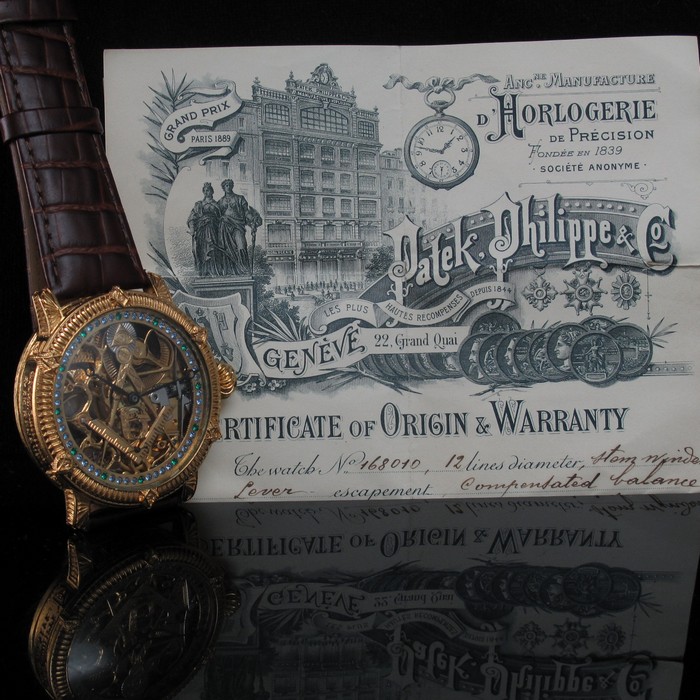
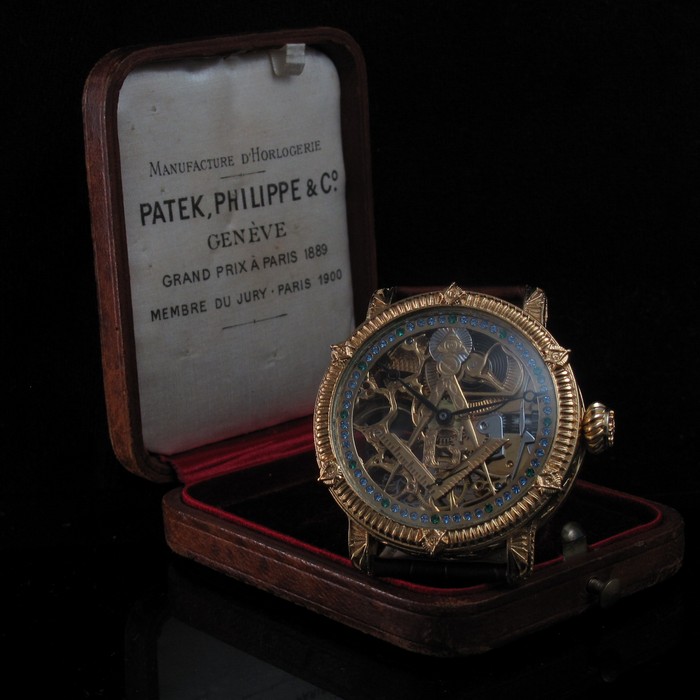
The movement is signed
PATEK, PHILIPPE & Cie – GENEVE. Also it signed movement serial
number #185,064. This serial number corresponds to the 1917 production date as
per published records of PATEK PHILIPPE & Co.
This
beautiful wristwatch has the
Original
magic GOLD-FILLED movement in an excellent status which was very well saved,
considering age of this watch and has been in addition updated and engraved by
the craftsman. Each part of the mechanism, each millimeter it is decorated by a
magnificent magic ornament. Mechanism has been recently serviced to ensure it
winds and sets smoothly while keeping great, accurate time.
You can see from any direction
the internal mechanics working as the balance wheel spins. They make an elegant
statement on the wrist. Watch aficionados and laymen alike when they see a high
quality skeletonized watch recognize its beauty. It is fitted on a new
24mm brown alligator style genuine leather strap with gold STAINLESS steel
buckle that is vintage style and goes great with this wonderful watch.
Diameter (with crown): 52.00 mm
Diameter (without crown): 47.00 mm
Watch crystal diameter: 39.00 mm
Thickness: 15.00 mm

PATEK PHILIPPE
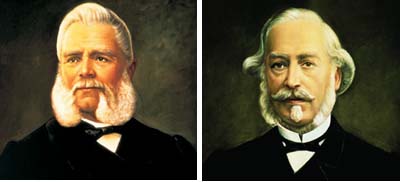
Patek Philippe & Co. is to watches what Rolls Royce is to cars—
synonymous with the best. This prestigious Swiss watchmaking firm is arguably
the most famous manufacturer of timepieces worldwide. To own a Patek Philippe
watch remains a symbol of wealth and importance: kings and queens were their
clients, while other watchmakers frantically copied them – imitation being the
highest form of flattery, and moreover a means to a more lucrative sale with the
help of the famous Patek Philippe signature. The Patek Philippe legend continues
to grow and fascinate. The soaring prices achieved by Patek Philippe watches at
auction—particularly within the last decade — prove to what degree these
precious timepieces are sought-after by collectors. One collector paid
$11,002,500 for a rare Patek Philippe pocket watch, thereby earning it a mention
in the Guinness Book of World Records.
The Company’s Beginnings
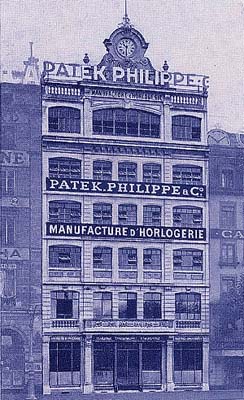
On May 1, 1839 in Geneva, Patek
and Franciszek Czapek established a business under the name of “Patek and Czapek”.
Czapek, a professional watchmaker, was also a soldier in the Polish National
Guard. Given their ties to the Polish community-both were involved in the Polish
Independence movement and members of the “Association of Polish Emigrés in
Switzerland”- Patek and Czapek had probably known each other for some time. The
earliest records place Czapek in Geneva on July 31, 1832, although it is
possible he arrived a year earlier. Not long after that date, he established a
watchmaking enterprise with a certain Mr. Moreau, called “Czapek and Moreau”.
Through Czapek, Patek met first Moreau, and then Moreau's niece, Marie- Adelaide
Thomasine. The two became engaged, and three months short of their wedding date,
Patek, Czapek, and Moreau signed an agreement establishing a new company.
Moreau and Patek each invested
8,000 Swiss francs in the company, Moreau held no official responsibilities,
while Patek was responsible for the ac-counting and management. Czapek, who
contri-buted tools and most likely some early machinery, was responsible for
production.
Paragraph five of their
agreement allotted him 100 francs monthly, in addition to his share of the
profits.
During the first 14 months Patek
and Czapek ran the company alone, possibly with the help of one or two workmen.
They purchased unfinished movements from various companies specialized in the
manufacturing of raw movements, sent them to a case maker to be cased, and then
finished them in their shop. Up until July of 1840 Czapek finished all movements
by himself. The company then hired one or two watchmakers to speed up the
finishing process and to help cope with the delays, a problem they apparently
faced in 1840. As Patek put it: “Being afraid of sustaining a loss in this new
for me field, a loss which I have experienced before in the trade, I was as
cautious as possible. I demanded that until July 1, 1840 all watches to be
finished by Czapek himself, it lowered the expenses but also caused delays. The
business allowing, two months ago (July, 1840) I increased the number of
craftsmen...” Their workers, he specified elsewhere, were paid by the piece.
The
earliest watches were signed Patek, Czapek & co. until 1845 when Czapek left the
partnership. Several years later the company was joined by French watchmaker,
Jean Adrien Philippe, who later became the inventor of their famous stem-winding
and hand setting mechanism, a modern and reliable concept. From May 1845 to
January 1851 the firm was known as Patek & Co; Philippe lent his name to the
company in 1851 when he became a full partner. Among the reasons for their
initial success was the high standard of watch making and practicality of
Philippe's new stem-winding system. In the early years of partnership.
Queen Victoria of England
herself was already a client. From the middle of the 19th century, Patek
Philippe assumed a leading role in the Swiss watchmaking industry by raising the
standards of workmanship and time keeping through the introduction of technical
improvements (the free mainspring, the sweep seconds hand), in addition to
implementing improvements to regulators, chronographs, and perpetual calendar
mechanism. As early as 1867 the Paris Exhibition, Patek Philippe displayed
watches featuring functions that were to become the standard for complicated
watches at the beginning of the 20th century; namely a perpetual calendar, a
repeater, and a chronograph with split-seconds.
The two most complicated
watches of all time were made by Patek Philippe. The first, made for Henry
Graves Jr. New York, was completed at the beginning of the century, and the
second, the Caliber 89, the world's most complicated watch, completed in 1989
(hence the name) to mark the firm's 150th anniversary. In 1932, Patek Philippe
changed hands, and its new owners became Charles and Jean Stern. Today the third
generation of this family sill owns and manages the company. Shortly after
Second World War, Patek Philippe established an electronic division, and in the
1950's the company pioneered quartz technology, filling several patents and
winning multiple awards. Today, Patek Philippe SA, Geneve, is still a family
company, owned jointly by its president, Mr. Henri Stern, and his son and Vice
President, Mr. Philippe Stern. The firm has traditionally made complete
timepieces, watches and clocks, employing craftsmen who are master-watchmakers
capable of designing and finishing the most complicated watch movements.
Other specialists such as
goldsmiths, chain smiths, enamellers, jewelers, and engravers complete the
firm's manufacturing capabilities. Although Patek Philippe is rightly famous of
the leading manufacture of mechanical horology, the firm is also the forefront
of the industry as producers of industrial and electronic timekeepers, with its
highly accurate master-clocks installed in power stations, hospitals, airports,
and other public buildings and factories. The firm clientele has included many
of the famous figures across history, including royalty such as Queen Victoria,
as well as distinguished scientists, artists, authors and musicians, including
Albert Einstein, Marie Curie, Charlotte Bronte and Tchaikovsky. Today, clearly
most of the firm's production consists of wristwatches, but Patek Philippe
retains the ability to produce pocket watches, and clocks to order, from highly
complicated movements to those decorated with enamelled miniature paintings and
engravings. The company continues to patent new inventions and improvements in
horology and plays an important role in maintaining the quality, prestige and
reputation of the Swiss watchmaking.
It is a
registered design model that features a three piece 24K GOLD-PLATED case that
provides with glass cover of back lid. This watch was converted from pocket
watch. The case, new custom made, fantastic, build specially for this wonderful
Patek Philippe movement. The lugs are in great condition
while the winding crown is in very good shape and operates properly.
The case has
MINERAL glasses on the front and back side. The case
is decorated HIGH QUALITY MASONIC ENGRAVING. The winding crown is decorated with
CALATRAVA CROSS. The case is signed
PATEK,PHILIPPE & Cie – GENEVE on the
lateral bezel.
